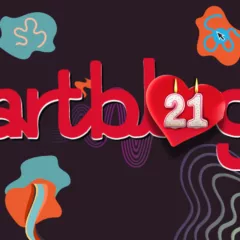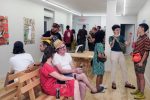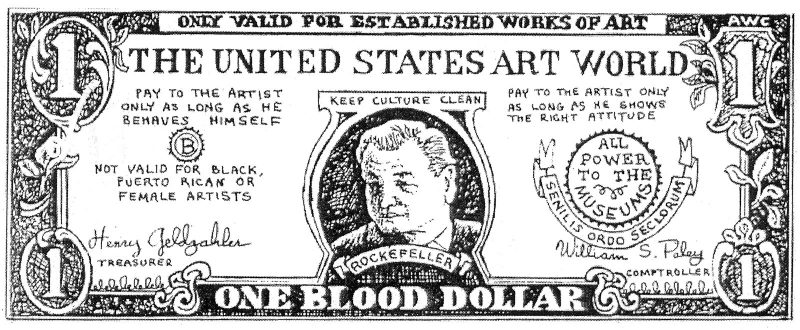
Anonymous Asks…
What do you think about the art of the steal? Better or worse than the art of the deal?
ABBA is that you? Seriously, I am actually not sure what the question is in this word salad hence my reason for not answering in 3 months, but here we are now ______________.* I’m going to go out on a limb and say that you are NOT talking about film “Art of the Steal” starring Kurt Russell as “Crunch Calhoun a semi-reformed art thief (what??? Like I guess he’s stealing from small alternative art spaces rather than art museums? Maybe he’s selling bootlegs from experimental sound performances? This is the literal description from IMDB) who agrees to get his gang back together to pull off one last heist.” And you are referring to the 2009 documentary “The Art of Steal” which lays out how exactly the Pew Charitable Trust (pretty much) stole the Barnes Foundation Collection and moved it to the Benjamin Franklin Parkway. Hey, I’m just going off what I learned from the documentary. You can read the response from the Pew on the topic of the Barnes Foundation on their website here which I am sure is entirely unbiased and true.
As for “The Art of the Deal” who else can we be talking about except none other than, Tony Schwartz, author of said book about Donald Trump’s financial genius. Let me clarify that even the author of “The Art of the Deal” proclaims it’s all bullsh*t and basically was put in production because Conde Nast saw Trump’s face sell magazines on the cover of GQ in 1984. Gross.
I believe “The Art of the Steal”. I do not believe billionaires – ever, not ever, never, no. I’m not opinion-ing about which space on the Parkway or Merion is better for visiting the collection. I am however in awe the Pew was able to turn from a privately funded organization with billions of dollars into a public charity that is now able to receive donations from the public. Look, I’m sure you can talk me into a corner and make my head spin over this, but plainly – that’s not right.
Billionaire is a coined word now. It’s a political signifier of the neoliberal global capitalist (I ran out of asshole words) take over and they own the artworld. I hit on this topic in a previous article “To organize or not to organize (an art festival), that is the question” (sorry for the title). Please go read that as I go on to explain that an art museum near you is funded by billionaires. Welcome back.
I see a similarity in the right now art world – or – artworldwise to what was happening in the United States in the 1960’s – 1980’s, (I mean look Dadaism, Surrealism and the Situationists predate this) which saw a rise of political art and activism across the country that led to a boom in alternative art spaces and artist collectives throughout inner cities across the United States. And that was a criticism of global capitalism, the patrons, the board of trustees, the art institutions where artists were exhibiting – the billionaires. Where today we are in an economic crisis being that the 1% dominate the capitalist market, the middle class is disappearing and the other 99% are left struggling to keep up and out of debt, or in debt or living in poverty. In comes activist art, which seems to be primarily on the Marxist side of things.
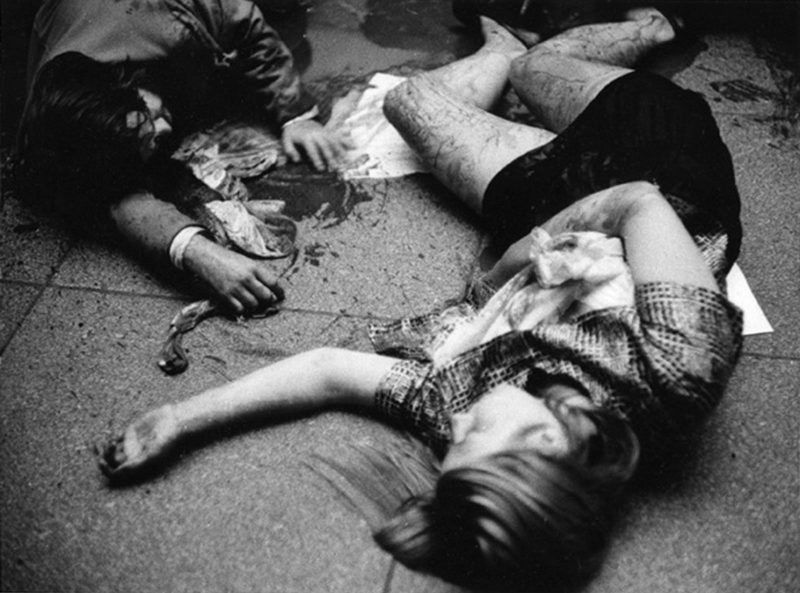
In the 1960’s the prominent figure of pointed artists protests was that of billionaire John D. Rockefeller – who’s wife Abby Aldrich Rockefeller partly established the Museum of Modern Art. Later numerous Rockefeller’s served on the Board of Trustees and the museum today is still largely funded through Rockefeller money. GAAG aka Guerrilla Art Action Group staged an action in November 1969 known as “Bloodbath at the Museum of Modern Art” where a number of anonymous persons ripped open concealed blood bags and writhed on the floor of the museum. That’s awesome. Manifestos were scattered about the scene with the message “immediate resignation of all the Rockefellers from the board of trustees of the museum. Rich people, the text contends, with a direct financial interest in the business of war, control of museums and their policies, and ‘sterilize art of any form of social protest.’” I am copying this text from a book I recently read and recommend “Art Gangs: Protest & Counterculture in New York City” by Alan Moore.
Now to today as I had mentioned in my previous post we have artists protesting under the title “Decolonize This Place” for the removal of Warren B. Kanders as Vice Chair of Whitney Museums Board of Trustees whose company Safariland, a tear gas manufacturer, was used against migrant refugees on the US/Mexico border in Tijuana. Kanders has responded via Art News “While my company and the museum have distinct missions, both are important contributors to our society. This is why I believe that the politicization of every aspect of public life, including commercial organizations and cultural institutions, is not productive or healthy.”
See, now, NO. It is imperative that artists are critical and aware, hence politicizing, the funding of cultural institutions. We already committed to a life of poverty when we decided to be artists – so what are we afraid of losing? [omg capitalist pigs I’m not saying artists should be in poverty] An Artist’s very nature is to be critical. Criticizing art institutions from the 1960’s into the 80’s (awe Institutional critique was born) was influential in boosting government funding for alternative artist projects and spaces while shaping conceptually what makes an art museum today. P.S. 1 was founded through the socially conscious curation of Alanna Heiss. Part of the New Museum’s curatorial practice, owning and supporting solely contemporary art, would not be here today without the action of artists’ protests of museum standards of practice in collecting art. The lack of vigilance on the part of the artist as public activist is what leads to corruption.
Back to today – the unionization of employees at the New Museum. As the museum itself purports via their about page, “We believe in the essential role of culture to a free and open civil society,” so pay your employees a living wage – free and open civil society includes economic equality. Speaking of W.A.G.E. – an organization working today to discuss fair pay for exhibiting artists – I’ve mentioned them in like every one of my advice column articles. Nice website, am I right? Now, go listen to this podcast from “The Art Newspaper” speaking to artist Tai Shani about arts labour – “Can Artists live off art alone?” Short answer is no.
Anon, it is better to be critical of our cultural institutions and to hold them accountable. Artists are foremost responsible in doing so. Even if you can’t understand how painting can be political aesthetically (you can protest an institution or the art market through withdrawing your artwork – Robert Morris did this.) Or you don’t understand that being political is a trend. Don’t tell Morandi, but POLITICAL ART IS A CONSTANT PART OF ALL ART MOVEMENTS THROUGHOUT HISTORY. Or maybe you don’t get that political art isn’t fun (it’s scary) or that being political is intimidating and might make you look naive.
There’s a reason all political arguments go directly to “you’re stupid.” How many times have you called me stupid to yourself while reading this article? Me? A lot. But as I am writing this now it’s as true as it was 50 years ago – the corporate interest aka greed is for U.S. intervention in Venezuela as it was for Vietnam.
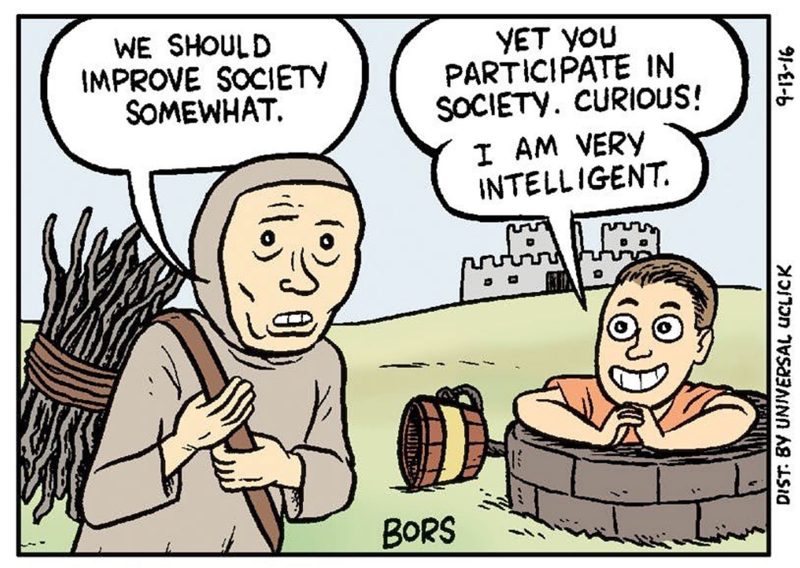
I’m yelling at myself here too – critical awareness in corporate, non-profit or private funding within the arts sector is a dense topic. It is a deep well, filled with dirty money.
Having been nominated for the Pew Fellowship I would not (like how could I?) – refuse $75,000 if I were to win. If I were to win, my art practice would be unilaterally funded (for a year or two) by Sunoco – a part of the Dakota Access Pipeline through a $20 billion merger with Energy Transfer Partners. Would you feel partly indebted to the Native American protesters at Standing Rock? I’m performing at the Philadelphia Museum of Art for local artist night in March – yikes. I have an iPhone. I have a Macbook which currently has nine applications operating, 100 tabs open in my browser and runs like a silent, efficient dream. Full disclosure, I was doored riding my bike and bought my computer through pain and suffering money.
Don’t allow yourself to be complicit. Overall, on “how to” in political activism with art, as I said in my previous article, the essential element is collective organization. An artist alone cannot tackle all these multi-millionaires and billionaires. OCGOPF’s performances in the past have been merely playful spectacles against authority, compared to the serious social impact a unified political front would have. Artists need to organize collectively and engage with local activist groups.
Alan Moore’s book “Art Gangs: Protest & Counterculture in New York City” ends poignantly in 2011 pairing global capitalism with the crisis of global warming, predicting artists will be a vital part of civilization visualizing that disastrous combination — among many other social wrongs and calls for resistance. It’s in all the history books, the artists are always among the first put in jail. No, don’t get arrested unless you can afford it. Look at that, some advice.
Sincerely,
Beth, Follower of the Church of ABBA and Righteous Hater Against Billionaires
Ask Artblog is the essential advice column for all your art life questions. Beth Heinly and Dave Kyu, our Advisors-In-Chief, offer solid advice from life experience and mature opinions on issues. Have a question for Dave or Beth? Email ask@theartblog.org. Or click here to submit a Google form with your questions.
Glossary
* “Here we are now, entertain us.” – Nirvana, Smells Like Teen Spirit
OCGOPF = Open Call Guerilla Outdoor Performance Festival
Church of ABBA = r/FurnaceParty




